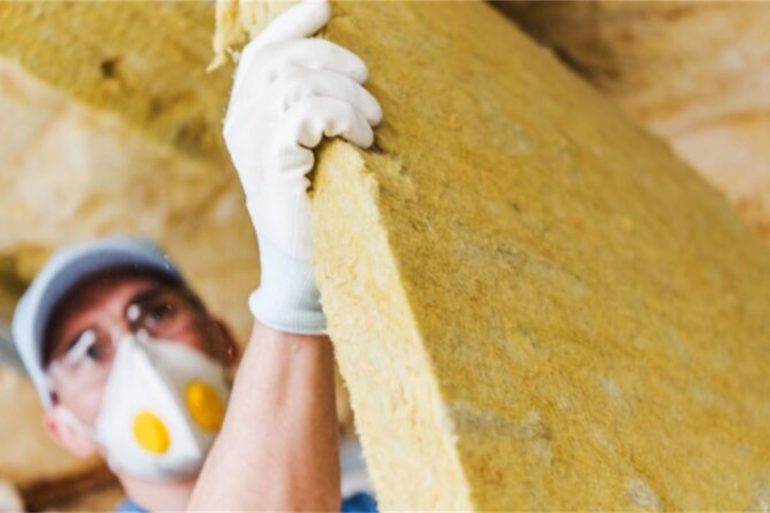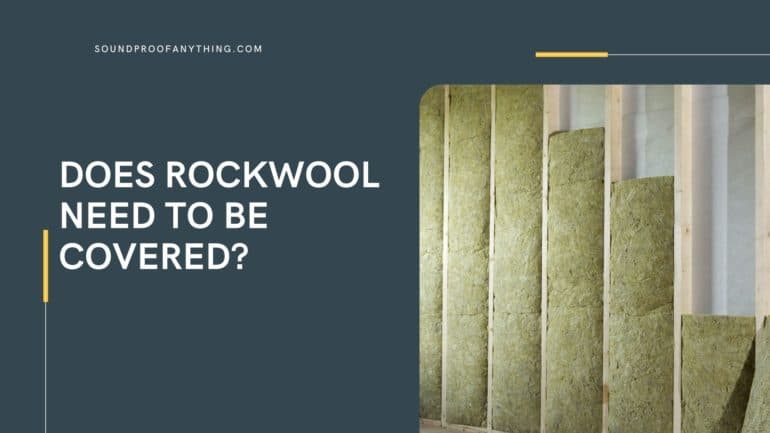So, you just installed some rockwool in your walls, attic, or in a ceiling, and you’re wondering if it’s ok to leave it like that of if it absolutely needs to be covered up. Maybe there are some health risks involved? Or maybe this could be detrimental to the rockwool itself?
In this article, I will cover what rockwool is, if it needs to be covered, if not covering it could pose potential risks, if it can be painted, if it’s flammable, its pros & cons, and more.
So, without any further ado, let’s get started!
Table of Contents
What is Rockwool or Mineral Wool?

Also known as mineral wool, rockwool is literally what the word implies: Rock fibers (volcanic rock and slag) which are spun and then given a specific shape (batt, pipe and board forms) and it’s generally made out of 75% recycled materials.
Rockwool is a great sound absorber since it’s thick and has a lot of air pockets inside of it, and it’s also worth mentioning that you can get different densities depending on your needs, and this is why it’s used so often to insulate homes, offices, buildings, factories, etc.
It’s not impermeable to water or vapor, and although it doesn’t absorb water like other types of wool, if it gets wet it won’t be able to insulate as well as when it’s dry. Luckily, since it’s made of rock, once it dries it’s as good as new.
Now, let’s go to the question at hand, shall we?
Does Rockwool need to be covered?
It’s completely fine to leave rockwool, or mineral wool, exposed since there are no safety concerns associated with doing so, plus rockwool itself is extremely durable, fire, water and mold resistant. The main benefit of covering rockwool, however, is to keep it from getting damaged and deteriorating over time.
There are plenty of reasons for covering rockwool though, be it from an aesthetic, or heat and sound insulation perspective, or to add some fire protection to the building, as well as to keep it from getting damaged or wet.
For example: If leaving the rockwool exposed means that it may come into contact with water, and even though water won’t directly harm it, this should be avoided since rockwool will lose quite a lot of its insulation capabilities while wet. Luckily, once it’s dry it will work just as it did before.
Additionally, it’s worth noting that some small particles will slowly but surely be released which can make their way into our respiratory system and slightly irritate it (more on health implications later on).
Is exposed rockwool considered a Health risk?

Studies have shown that rockwool can release some small particles into the air which, when breathed in, can cause irritation in the respiratory system, but since the fibers are single monofilament strands and do not separate into thin fibrils such as asbestos and will not penetrate the cell walls within the body. This is why rockwool is not as harmful to breathe in as asbestos, or even fiberglass, and since rockwool fibers are short and thick, the body can easily expel them.
The dust from rockwool can also very slightly irritate the skin as well as eyes, although I have never had any issues when working with it, so it’s generally recommended to use goggles and gloves while handling it.
Is Rockwool Flammable?

If there’s one thing you need to consider when deciding what insulation to put into your one, it’s fire safety and if the insulation will contribute to a fire or not. As far as rockwool goes, covered or not, the results are the same:
Rockwool has a flame spread index below 25 and a smoke development rating of 50, which is as low as any insulation material can be, plus it can withstand up to 1.000°C. This means that rockwool is not considered a fire hazard and that it’s an insulation material that will probably never burn or contribute to the spread of a fire.
How flammable a material is, is represented by the flame spread index which is separated into 3 categories each with a different numerical value attached to it: A (0-25), B (26-75), and C (76-200).
The higher the number, the more flammable, or less fireproof a material is. So, Rockwool is considered to be one of the safest materials in terms of fire safety and could even be considered fire-blocking since, well, it’s made out of rock.
Can you Paint over Mineral Wool Insulation (Rockwool)?
You might be thinking about painting over rockwool to keep it from shedding, or simply so you don’t have to cover it up with something like drywall since it would be far more expensive, but us this really a possibility?
As far as I know, there is no problem with lightly painting the bats using a sprayer and some latex paint, which will act as a binder and keep rockwool from shedding some fibers (although that is generally not too big of an issue anyway). The only issue I see happening is if you excessively paint it using a type of coating that ends up acting like an air barrier, since this will reduce the insulation effectiveness of the rockwool.
Does rockwool need ventilation?
If you don’t ventilate properly, water vapor can condense and collect on insulation and rafters. This will reduce the effectiveness of rockwool insulation and could damage the house. Also, without ventilation, heat could penetrate into living areas during summer.
How much ventilation is needed?
The amount of ventilation required highly depends on where the rockwool was installed (walls, attic, floor/basement ceiling, etc.).
For example, one square foot of vent is needed for every 300 square feet of attic area. If you do not have a vapor barrier in this area, the amount of ventilation could be doubled (up to one square foot of vent for every 150 square feet of attic area).
Also keep in mind that screens and louvers on vents reduce venting capacity, so openings must be increased proportionately. Use a combination of vents, half located low on the roof and half higher up, so air can flow in one and out the other, such as soffit and ridge vents.
Crawl spaces and basements also need to be ventilated. Basements should be ventilated to the outside (one square foot of vent for every 1,500 square feet of floor area) with vents placed on opposite walls for cross ventilation.
Is rockwool mold resistant?

The composition of rockwool makes it an ideal material to be used in rooms that are generally prone to high humidity levels, such as bathrooms and kitchens, which are is the best environment for mold and mildew growth.
Since it’s moisture resistant and vapor permeable, this means that any liquid water will just drain away, while vapor will pass through it without dampening the material.
Because of these reasons, and also because rockwool is an inorganic material that does not provide any food source for mold to grow, it passes the Fungi Resistance test with a “zero fungal growth” rating.
Rockwool Insulation Pros
- Saves Energy: Insulating your home means that there is much less temperature loss inside of the house, resulting in a warmer home in winter and cooler in the summer without having to turn on the heating or AC as much (lower gas and electricity bills).
- Fire Retardant: Rockwool can withstand extremely high temperatures and won’t help a fire spread, which is why it’s one of the best insulation materials out there.
- Moisture and water Resistant: It’s not a vapor barrier and moisture will get through it, but if it gets wet you can simply let it dry and it will be as good as new.
- Not Toxic.
- Mold Resistant: Inorganic matter and doesn’t absorb moisture.
Rockwool insulation Cons
There definitely are more pros than cons to rockwool, but some of its shortcomings include:
- It settles over time and may leave an open air gap where heat and sound can get through.
- It may shed some fibers which can irritate your skin, eyes and respiratory system.
- It generally doesn’t last as long as fiberglass or spray foam if not installed properly.
- It loses some insulation efficiency if it gets wet.
Rockwool’s R-Value
An insulating material’s resistance to conductive heat flow is measured or rated in terms of its thermal resistance or R-value. Basically, the higher the R-value, the greater the insulating effectiveness.
The R-value depends on the type of insulation, its thickness, and its density, as well as on temperature, aging, and moisture accumulation.
When calculating the R-value of a multilayered installation, you simply need to add the R-values of the individual layers.
As far as rockwool goes, it offers an R-Value of 3.0 to 3.3 per inch of thickness.
You can use this R-Value Calculator to find out what materials and what thickness/density of rockwool you need to get a certain insulation value.
Rockwool’s STC Rating
STC, or Sound transmission class, is the rating used in the US to describe how well a building partition can attenuate sound, such as interior partitions, ceilings, floors, doors, windows, etc.
In most other countries, the Sound Reduction index is used (SRI).
The STC rating reflects the decibel reduction of noise that a partition can provide (1 STC is equivalent to 1dB reduction), where a higher number, or rating, equals better results, or overall attenuation.
Here’s a table showing what each STC rating represents:
| STC | What can be heard |
| 25 | Normal speech can be understood |
| 30 | Loud speech can be understood |
| 35 | Loud speech audible but not intelligible |
| 40 | Loud speech audible as a murmur |
| 45 | Loud speech heard but not audible |
| 50 | Loud sounds faintly heard |
| 60+ | Good soundproofing; most sounds do not disturb neighboring residents. |
Here’s how Rockwool performs:
Putting rockwool inside a typical interior wall with ½” of drywall on either side, which has an STC (sound transmission class) rating of 34 on its own, will increase that STC rating to 45. If you install a single sheet of drywall on top of an existing wall and you fill the air gap with rockwool, the reduction in sound transmission will be quite noticeable.
Conclusion
Rockwool does not need to be covered since it won’t really affect your health in a negative way (maybe some skin, eye and respiratory system irritation, but not in a serious way), and it’s also not harmful for rockwool to be exposed since humidity, water, and other elements, aren’t really going to do anything to it.
Of course, covering it with drywall, or any other type of material, will help increase its insulation capabilities, both in terms of sound and heat loss.
Sources:
http://www.hipspro.com/insul/factsinsvent.html#ventilation
https://www.buildingscience.com/documents/insights/bsi-009-new-light-in-crawlspaces
https://www.hunker.com/12549958/what-are-the-dangers-of-rockwool
https://en.wikipedia.org/wiki/Mineral_wool
Last Updated on February 24, 2022 by Facundo
